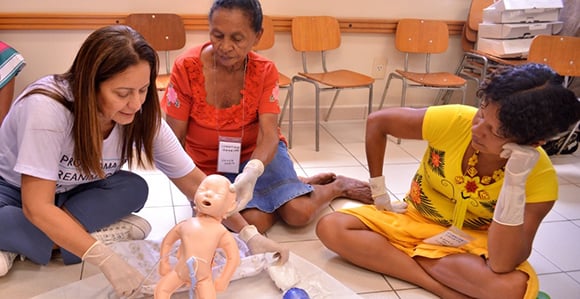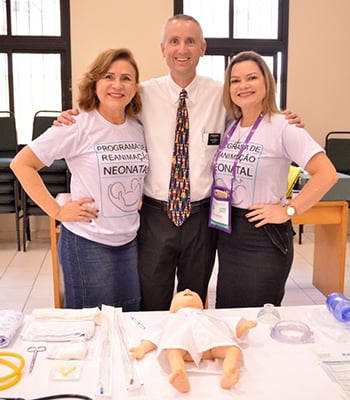Church-Provided Training, Equipment Helps Indigenous Midwives Save Newborns in Brazil
Contributed By Jason Swensen, Church News associate editor

An instructor demonstrates neonatal care techniques to Guajajára midwives at an October 2018 training seminar in northern Brazil that was cosponsored by the Church.
“It’s been so rewarding to work with the midwives because they are so excited that people are taking time out to help them. … It’s hoped that we can make a huge impact on [decreasing] the infant mortality rates in their communities.” —Elder Ryan Wilcox, Church medical missionary
Related Links
At first glance, the people who gathered recently inside a Sao Luis stake center in northern Brazil seemed a disparate group.
Some wore shirts and ties while others donned the colorful skirts and the traditional beadwork of local indigenous tribes. Most spoke Portuguese as their first language, but some conversed in their native Guajajára. Many held advanced degrees. A few could not read or write.
But all shared a common, even sacred, purpose: keeping babies alive in the sometimes perilous first moments after birth.
Brazil’s Maranhao region, which is home to thousands of indigenous people, has a high infant mortality rate. There are 16.3 deaths per thousand births, according to the Ministry of Health.
In response, The Church of Jesus Christ of Latter-day Saints and the Society of Pediatrics of Maranhao once again partnered last October to host the Pediatric Neonatal Day—an annual course that trains local health professionals in advanced techniques of neonatal resuscitation.
Babies not being able to breathe at birth cause most infant deaths, said Elder Ryan Wilcox, a physician and Church medical missionary. “Nine out of 10 babies are fine at birth—it’s the 10 percent that need help, and most of the time it is often just a matter of simply opening their lungs up quickly.”

Church medical missionary Elder Ryan Wilcox, center, is joined at a neonatal care training seminar by Brazilian pediatricians Dr. Marynea Silva do Vale, left, and Dr. Patricia Marques. Photo courtesy of the Brazil Area.
So it is critical that the doctors or midwives delivering the babies possess the know-how and proper equipment to respond immediately.
“The whole purpose of the course is to identify when a baby is having problems at the moment of birth,” said Elder Wilcox. “The key thing is then grabbing a bag and mask to ventilate the baby. In the course, we teach [care providers] how to use the bag and mask properly.”
Elder Wilcox has become a familiar face at the annual gathering in Brazil. A pediatrician from American Fork, Utah, he has spent more than a decade teaching and working with local medical providers. He and his wife, Gretchen, a labor and delivery nurse, are medical missionaries assigned to the maternal/newborn care project, one of the Church’s major welfare initiatives.
The Church’s neonatal resuscitation efforts in Brazil are made possible through local partnerships, he said. He and other medical missionaries enjoy time-tested relationships with health and physician organizations in Brazil sharing a commitment to saving newborn babies.
The most recent Pediatric Neonatal Day was attended by dozens of doctors and nurses, along with 24 midwives from local communities and indigenous villages.
Besides offering neonatal resuscitation training, the Church donated more than 2,000 pieces of medical equipment, including stethoscopes, self-inflating silicone bags, masks, neonatal mannequins, and syringes.
“The partnership with The Church of Jesus Christ of Latter-day Saints is so valuable,” said Marynea Silva do Vale, a pediatrician and president of the Society of Child Care and Pediatrics of Maranhao. “Together, we have been able to promote training once a year in Brazil in places where child mortality is very pronounced.”
Working with the indigenous midwives marked a special opportunity for Elder and Sister Wilcox.
“It’s been so rewarding to work with the midwives because they are so excited that people are taking time out to help them,” said Elder Wilcox. “It’s hoped that we can make a huge impact on [decreasing] the infant mortality rates in their communities.”
The burgeoning friendship between the Church medical missionaries and the midwives is anchored in respect and professional fellowship. The Wilcoxes have met some midwives who have performed hundreds of newborn deliveries in their respective villages.
“The course was wonderful, and it will help a lot,” Maria Jose, a midwife from the Sao Jose Ribamar community who has been delivering babies for 35 years, told Newsroom in Brazil.
Maria Jose added she planned to return to her community and share the things she has learned with fellow midwives.
“I’m better prepared now,” she said.
The Church’s ongoing neonatal care effort in Brazil has gleaned attention outside the country’s medical community. Several news and television stations covered the gathering, allowing Elder Wilcox to utilize the Portuguese-language skills he learned as a young missionary in Brazil during multiple media interviews.
A veteran pediatrician, Elder Wilcox said he still discovers wonder in the birth of a healthy baby. Many of the people he works with in Brazil come from starkly different backgrounds, but they share his joy in welcoming little ones to the world.
“It’s been a lot of fun going back to Brazil and once again wear the missionary name tag, even though it’s in a completely different role,” he said.
Newborn lives are being saved, he added, in the indigenous villages of northern Brazil and far beyond, thanks to the generosity of Church members worldwide who donate to the humanitarian fund.

Midwives from Brazil’s Guajajára tribe listen to neonatal care instruction at an October 2018 training seminar cosponsored by the Church. Photo courtesy of the Brazil Area.
